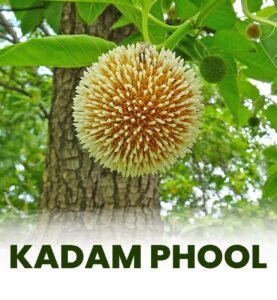
Kadam Phool: The Fragrant Beauty of India
India, often referred to as the land of spices and diverse flora, is home to a vast array of aromatic plants and flowers. Among these, the kadam phool (Neolamarckia cadamba), also known as the kadamba flower, holds a special place. Its sweet, enchanting fragrance and vibrant yellow-orange blossoms have made it a symbol of beauty and spirituality in Indian culture. In this blog, we will explore the significance, characteristics, and cultural importance of the kadam phool.
Characteristics of Kadam Phool
The kadam tree is an evergreen tropical tree that can grow up to 45 meters in height. It is native to the Indian subcontinent and can be found in various parts of South Asia, including India, Bangladesh, Sri Lanka, and Nepal. The tree is renowned for its distinctive umbrella-like canopy of leaves and its cluster of small, globe-shaped flowers.
1. Flowers: The kadam flowers are the most prominent feature of the tree. These blossoms are typically small, measuring around 2-2.5 cm in diameter. They have a unique appearance with multiple layers of petals and a vivid yellow-orange color. The fragrance of the kadam flower is captivating, often described as sweet and reminiscent of honey.
2. Leaves: The kadam tree’s leaves are dark green, glossy, and simple in structure. They are arranged alternately on the branches and provide a lush canopy that offers shade and protection to the tree’s surroundings.
3. Fruits: Kadam trees also produce small, greenish fruits that are about 1-2 cm in diameter. These fruits are not commonly consumed by humans but are a food source for various birds and animals.
Cultural Significance
The kadam phool holds immense cultural and religious significance in India, especially in Hinduism. Here are some of the ways in which it is revered:
1. Religious Rituals: The kadam flower is frequently used in Hindu religious ceremonies and rituals. It is offered to deities and used to adorn idols in temples and homes during festivals and pujas.
2. Krishna and Radha: In Hindu mythology, the kadam tree is associated with Lord Krishna, often depicted with a flute in one hand and a garland of kadamba flowers around his neck. These flowers are believed to be the favorite of Lord Krishna and symbolize his love for Radha.
3. Festivals: The Kadamba Navami festival is celebrated in some parts of India to honor the kadam tree and its flowers. Devotees visit temples, offer prayers, and participate in various cultural activities during this festival.
4. Aesthetic Inspiration: The beauty and fragrance of the kadam flower have inspired poets, artists, and musicians in India for centuries. It is a common motif in classical Indian art and literature, symbolizing love, beauty, and spirituality.
The kadam phool, with its mesmerizing beauty and sweet fragrance, is more than just a flower; it is a symbol of India’s rich cultural and religious heritage. Its association with Lord Krishna and its role in religious rituals make it a revered and cherished flower in the country. As the kadamba tree continues to thrive across the Indian subcontinent, so does its significance in the hearts of the people, reminding them of the timeless beauty and spirituality that permeates their land.


